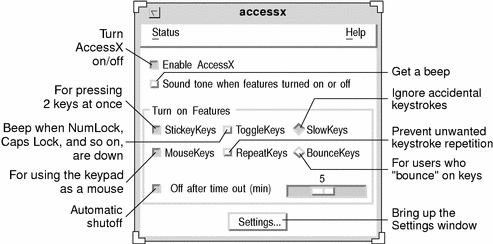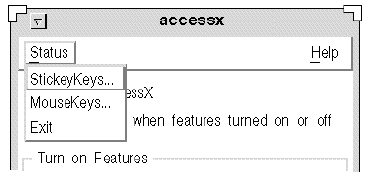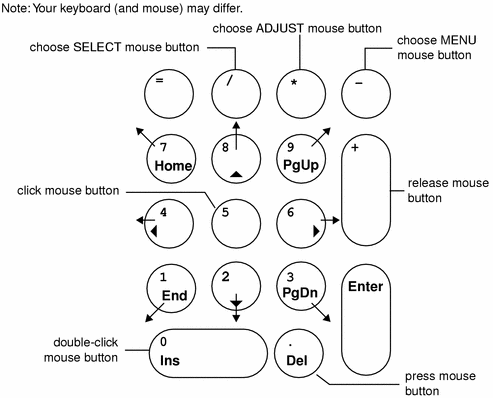Appendix E Access for Users With Disabilities
Many users with disabilities have trouble using the standard keyboard and mouse on computers. They may find it difficult or impossible to hold down two keys at once (to type capital letters or control characters), or to use a mouse, or type accurately.
AccessX is an extension to CDE that makes it easier for people with disabilities to use a keyboard and to move a pointer around their screen. With AccessX running, you can:
-
Keep the Control, Shift, Alt, and Meta keys pressed and active while you press another key, enabling you to type capital letters, Control-C, Alt-M, and so forth. (See StickyKeys.)
Note –Not all keyboards have all these keys. On some keyboards, for example, the Meta key is replaced by Control-Alt.
-
Use the numeric keypad to emulate the mouse. You can move a pointer around the screen and perform mouse button actions (for instance, double-clicking), all from the keyboard. (See MouseKeys.)
-
Make the computer beep when certain keys are activated or deactivated; people with limited vision can then tell whether, for example, the Caps Lock key is on. (See ToggleKeys.)
-
Prevent a key from repeating if you have trouble releasing it quickly. (See RepeatKeys.)
-
Prevent a key that you hit accidentally from inputting to the system. (See SlowKeys.)
-
Make a key accept input as intended, even if you are unable to hold the key down steadily. (See BounceKeys.)
Starting AccessX
If you've brought up CDE, and no AccessX windows are already up on your screen, type accessx & in a command window.
If you're running AccessX and want to have AccessX windows come up automatically when you start OpenWindows, choose Save Workspace from the Utilities submenu of the main (background) OpenWindows menu.
The AccessX Main Window
After you type accessx &, this window appears:
Figure E–1 The AccessX Main Window

Displaying the Status of Buttons and Keys
From the Status menu, you can display two windows that show the status of mouse buttons and certain keys. The StickyKey status window indicates if a key such as Control or Shift is pressed; the MouseKeys status window does the same for mouse buttons.
To open the Status menu, either use the MENU mouse button, or press the F10 key and the letter s. Use the arrow keys to move through the menu.
Figure E–2 The Status Menu

Note –
If you're using StickyKeys or MouseKeys, it's a good idea to display the status window for that feature. Otherwise, you may encounter unexpected behavior that can be very confusing. In StickyKeys, for example, if the Control key is “locked” down, pressing the letter c sends a Control-C to the computer. The StickyKeys status window reminds you that Control is active.
Getting a Beep When a Feature is Turned On or Off
The main window has a check box labeled “Sound when features turned On/Off.” (See Figure E–1.) If you check this box, any time a feature such as StickyKeys or SlowKeys is activated or deactivated, the computer beeps.
Setting the Automatic Shutoff Timer
If you share your computer with someone who doesn't use AccessX, you may want to have AccessX turn itself off automatically if the machine isn't used for a certain period of time. That way, neither you nor the person who uses your machine after you has to remember to shut off AccessX.
To activate this timeout, check the “Off after time out (min)” check box. (See Figure E–1.) Move the associated slider to set the amount of time AccessX should wait without input before disabling itself. You can set this time to be anywhere from zero to six minutes.
Getting On-Line Help
AccessX has several help windows; choose the subject that interests you from the main window's Help menu. To open this menu, either use the MENU mouse button, or press F10 and the letter h. Use the arrow keys to move through the menu.
Figure E–3 The Help Menu

The Settings Window
Click the Settings button in the AccessX main window to display the Settings window. This window displays adjustable parameters for various AccessX features. These parameters are discussed in the section covering each individual feature.
Figure E–4 The AccessX Settings Window

Individual Features
StickyKeys
Many people with disabilities have trouble holding down two keys at once, making combinations like Control-D or Shift-Mouse-Click difficult. When StickyKeys is turned on, modifier keys (generally, Shift, Alt, Control, and Meta) stay active while you type another key or click a mouse button.
Turning StickyKeys On and Off
There are three ways to turn StickyKeys off:
-
Check the StickyKeys check box in the AccessX main window.
-
Press a modifier and any other key — for example, Shift-x or Control-Shift (valid only if you've started OpenWindows with the -accessx option).
-
Press two modifier keys at once (see under StickyKeys Settings).
Latching and Locking
Sticky keys may be either latched or locked:
-
You latch a modifier key by pressing it once.
A latched key stays active until a non-modifier key is pressed. Suppose that, with StickyKeys on, you press the Control key. It will stay “pressed” while you press the l key, giving you Control-L. Once you press l, Control is “released.”
-
You lock a modifier key by pressing it twice in succession.
The key stays locked until you press it again. For example, suppose you want to enter
:WR |
In this case, you would press Shift twice to lock it. Then you'd press the colon key and the letters w and r. To unlock Shift, press it again.
You can bring up a Status window to see which keys are latched or locked. (See Displaying the Status of Buttons and Keys.)
StickyKeys Settings
Getting a Beep Whenever a Modifier is Pressed
You can have your computer beep every time you press a modifier key (with StickyKeys on). Since pressing these keys latches, locks, or releases them, a beep can be a useful reminder that you've enabled or disabled a modifier. (It's easy to forget this in the course of normal typing.)
To enable this setting, check the “Sound when modifier pressed” check box in the Settings window. (See Figure E–4.)
Turning StickyKeys Off by Pressing Two Modifiers at Once
When you check this box (in the Settings window), you allow yourself to turn off StickyKeys by pressing two modifiers at once (such as Control and Shift). Some people find this easier than clicking with a mouse or pressing Shift five times.
MouseKeys
If you have trouble using a mouse, use MouseKeys to make the numeric keypad on your keyboard emulate mouse actions. You can move the pointer around your screen, as you would with a mouse, and click or press mouse buttons.
Turning MouseKeys On and Off
There are two ways to turn MouseKeys on and off:
-
Check the MouseKeys check box on the AccessX main window
-
Press the Alt, Shift, and Num Lock keys at once. (Valid only if you've started OpenWindows with the -accessx option.)
Keyboard Emulations of Mouse Actions
When MouseKeys is turned on, the keys on the numeric pad have three different kinds of functions:
-
Keys 1-4 and 6-9 move the pointer around the screen.
-
The 5, + (plus), 0 (zero) and . (decimal point) keys simulate mouse button clicks and presses.
-
The /(slash), * (multiply), and - (minus) keys switch the keyboard mapping between various mouse buttons.
You can bring up a Status window to see which mouse keys are currently pressed.
Figure E–5 Mouse Button Equivalents for a Numeric Keypad

MouseKeys Settings
Changing the Maximum Speed of the Pointer
If you have trouble moving the pointer with the accuracy you want, you can slow it down. To change how fast the pointer moves, check the box marked “Max. pointer speed (pix/sec).” (SeeFigure E–4 .) Adjust its slider bar to the speed that you want. The speed is in pixels/per second, and can range from 10 up to 1000. [Limits on pointer speed apply only when MouseKeys is turned on.]
Setting the “Ramp-Up” Speed for the Pointer
You can set how fast the pointer reaches its maximum speed (when MouseKeys is set). To do this, adjust the slider marked “Time to max speed” (see Figure E–4.) This way, you can be more deliberate in moving the pointer. You can set the mouse to take up to four seconds to reach full speed.
ToggleKeys
Many keyboards have indicator lights (LEDs) that light up when certain keys are active. An example of this is the Caps Lock key. When Caps Lock is pressed, its indicator light goes on.
For people with no or little eyesight, these indicator lights are of limited use. The ToggleKeys feature serves as the aural equivalent of such a light. When you make Num Lock, Caps Lock, or Scroll Lock active, the computer beeps once. When you deactivate the key, the computer beeps twice.
Turning ToggleKeys On and Off
Check the ToggleKeys check box in the AccessX main window to turn this feature on and off.
RepeatKeys
Some users with limited motor abilities have a hard time taking their finger (or mouth stick) off keys quickly. As a result, for example, they sometimes type kkkkkkkkk when they mean to type k,. With RepeatKeys on, a key must be held down for a certain length of time before it starts to repeat.
Turning RepeatKeys On and Off
There are two ways to turn RepeatKeys on and off:
-
Check the RepeatKeys check box in the AccessX main window.
-
Hold down the Shift key (either one) for eight seconds.
The computer beeps at four seconds to let you know that you're turning this feature on or off. (Valid only if you've started OpenWindows with the -accessx option.)
Note –
Holding down the Shift key for eight seconds also turns on SlowKeys.
RepeatKeys Settings
Delaying the Onset of Repetition
You can set the amount of time you want a key to be pressed before it begins repeating. This interval can be anywhere from a tenth of a second up to ten seconds. To set this parameter, move the “Delay until repeat” slider (see Figure E–4) to the number of seconds you want keys to wait before repeating.
Setting the Rate of Repeating
You can also set the repeat rate. The repeat rate represents how many times a pressed key will repeat per second. The rate ranges from 0.1 (that is, ten seconds per key) to 10 (that is, ten keys per second). The higher you set this value, the faster the key repeats. Set this to a low value to keep a pressed key from repeating, or from repeating too quickly.
Move the “Repeat rate” slider to the value you want. (See Figure E–4.)
SlowKeys
Users who have trouble typing often hit the wrong key, or keys, while trying to type. They may, for example, hit r while reaching to type t. When SlowKeys is turned on, only keys that are held down for a minimum, specified time will be accepted as input. Keys that are hit inadvertently will not register.
Note –
Both SlowKeys and BounceKeys cannot be active at once.
Turning SlowKeys On and Off
Turn SlowKeys on and off in either of these ways:
-
Check the SlowKeys check box on the AccessX main window
-
Hold either Shift key down for at least eight seconds. The machine will beep at four seconds to let you know you're turning this feature on or off. (Valid only if you've started OpenWindows with the -accessx option.)
Note –
Holding down the Shift key for eight seconds also turns on RepeatKeys.
SlowKeys Settings
Setting the Notification Style
You may want to be notified of a key's status while SlowKeys is active. That way you don't have to guess whether you've held the key down long enough for it to be accepted.
There are two check boxes (“pressed” and “accepted”) in the Settings window for setting how you want to be notified of a key's status when SlowKeys is in effect. By checking these boxes, you can have your machine beep:
-
When a key is initially pressed
-
When the key-press is accepted
-
Both when the key is first pressed and when the key-press is accepted
-
Not at all
Setting the Acceptance Delay
The acceptance delay is the interval between when you first press a key and when it transmits input. You can set this with the “Acceptance delay (sec” slider located in the Settings window. (See Figure E–4.) This delay can range from zero to five seconds.
BounceKeys
BounceKeys aids people who have trouble holding down a key, or who tend to hit a key repeatedly when they mean to press it only once. BounceKeys sets the window system to ignore rapid, repeated pressings of a single key.
Note –
Both SlowKeys and BounceKeys cannot be active at once.
Turning BounceKeys On and Off
To turn BounceKeys on and off, check the BounceKeys check box on the AccessX main window.
BounceKey Settings
Setting the Debounce Time
The Debounce Time is the interval that must pass before a second pressing of a key is accepted.
You can set this interval with the “Debounce time (sec)” slider. (See Figure E–4.) This delay can range from zero to five seconds.
Keystrokes for AccessX Features
Table E–1 shows the various AccessX features and their associated keystrokes. You must start OpenWindows with the -accessx option to use these keystrokes.
Table E–1 Features and Their Keystrokes|
Feature |
Keystroke |
|
|---|---|---|
|
Turn StickyKeys on or off. |
Press Shift five times. |
|
|
Turn StickyKeys off. |
Press any two modifiers (e.g., Shift and Alt) at once. Note: You must turn this ability on from the Settings menu. |
|
|
Turn MouseKeys on or off. |
Alt - Shift - Num Lock |
|
|
Move the pointer (when MouseKeys is turned on). |
1-4, 6-9 keys on the numeric keypad |
|
|
|
Click Double-click Press Release |
5 0 . + |
|
SELECT (mb1) ADJUST (mb2) MENU (mb3) |
/ * - |
|
|
Turn RepeatKeys on or off. |
Hold down Shift for eight seconds (beeps at four seconds) |
|
|
Turn SlowKeys on or off. |
Hold down Shift for eight seconds (beeps at four seconds) |
|
- © 2010, Oracle Corporation and/or its affiliates
